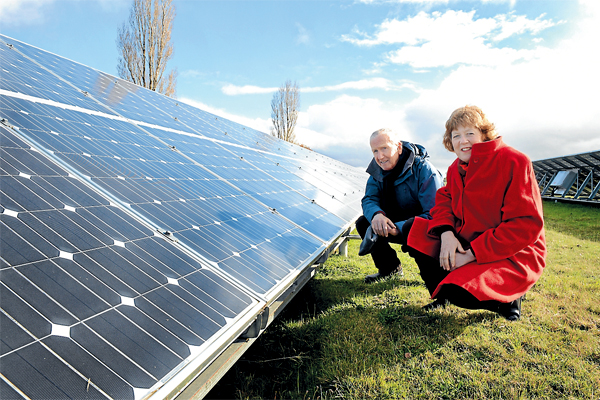STATE and federal governments need to encourage smaller-scale community renewable energy (CRE) projects, according to sustainability leaders.
They say promoting community-owned models could be the key to engaging the wider public in lowering carbon emissions.
Deb Porter, secretary of Moorabool Environment Group (MEG), said the group was looking at developing a community solar farm in Bacchus Marsh, with people purchasing shares.
“It would generate power for the whole community and could even generate tourism interest,” she said.
“Power bills would be contained and power and control given back to the community. Not every roof is suitable for panels. Renters can’t, for example.”
WHAT DO YOU THINK? SCROLL TO THE BOTTOM OF THIS STORY TO POST A COMMENT.
Parwan farmer and MEG president Kate Tubbs said she would give over parts of her land for a solar farm.
“Costs now are hitting people hard. Utility costs are getting to my mother. If she could put money into solar and get something back she would be very happy,” she said.
Chief executive of Sustainable Regional Australia Leah Sertori said large companies had approached her to help them reduce energy consumption.
The Castlemaine-based group has set up two 300-kilowatt solar parks in Ballarat and Bendigo, which pump about 450 megawatt hours of power back into the grid each year.
“It’s a myth that the only people supportive of CRE are tree-hugging hippies,” she said.
“We have been working with manufacturing and heavy industry companies like Keech Castings, which makes mining industry tools in Bendigo, and they want to shift to renewables and community models.
“In my view, it can’t be resolved between communities and [utility] companies. It needs government intervention; it would be a David and Goliath battle, an unfair battle.”
Ms Sertori said the state government should look at community energy as a vehicle for promoting economic growth. “Environment policies aside, it makes good business sense,” she said.
Brian Lennon, chairman of community solar farm Ranges Energy, based in Melbourne’s outer east, said community projects had been proven to foster support for renewable energy.
He said countries like Denmark and Germany were among the biggest solar powers worldwide, with the latter employing about 400,000 people in the sector. “What really kills me is that some of the best technology for solar and wind is being developed in Australia,” Mr Lennon said.
A spokeswoman for Energy and Resources Minister Michael O’Brien said a transition away from coal was not technically or economically viable at the moment.
“We have continued our support for appropriate and fair solar feed-in tariff (FiT) schemes through the new transitional feed-in tariff and by initiating a review by the Victorian Competition and Efficiency Commission,” he said.
Mr Lennon said governments had hampered the solar industry through FiT schemes, which were “all over the place” in Australia and “chopping and changing constantly”.
He pointed to Germany’s Renewable Energy Act, which 40 countries had adopted, as a model Australia should consider, saying the policy ensured investment protection through guaranteed feed-in tariffs and connection requirements.
Friends of the Earth renewable energy campaigner Ben Courtice agreed.
“Germany has much more medium to large-scale solar installations than Australia despite having less sun,” he said.
“What’s interesting is that their feed-in tariff arrangements support this, whereas larger-scale installations in Australia don’t attract the tariff.”







